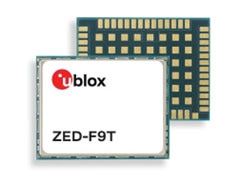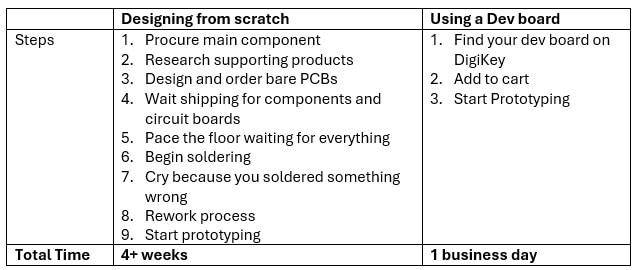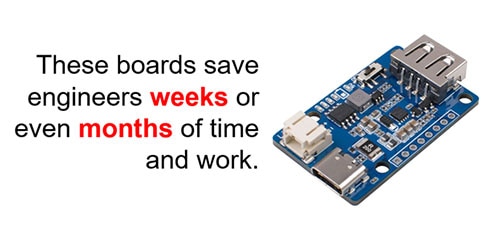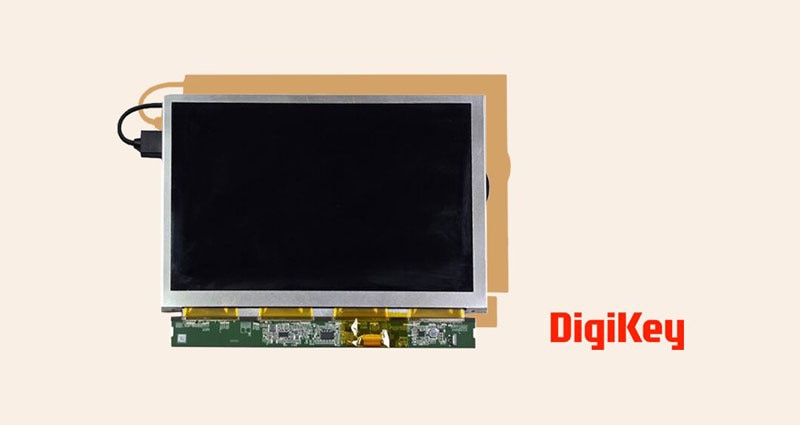簡單、快速、便利地進行原型設計
一個小問題:您知道如何輕鬆地手工焊接 54-SMD 封裝嗎?(圖 1)
 圖 1:針對原型設計手工焊接表面黏著零件 (如 u-blox 的 ZED-F9T GNSS 模組) 幾乎不可能。(圖片來源:u-blox)
圖 1:針對原型設計手工焊接表面黏著零件 (如 u-blox 的 ZED-F9T GNSS 模組) 幾乎不可能。(圖片來源:u-blox)
我也不知道。
雖然處理表面黏著產品並非不可能,但絕對是一大阻礙。幸好,我們不需要深入研究進階的焊接方法,因為還有另一種方式:我們可以使用開發板,輕鬆快速地進行原型設計。
開發板包括評估板、展示板、評估分接板等產品,是已裝配組件的印刷電路板,以便利的方式提供主要組件。這些電路板包含特定產品,如微控制器、感測器、按鈕、通訊模組或麥克風,用於探索元件的功能。此外,也可以是一些組件的組合,用於某種目的,如通訊等。開發板從簡單的設計 (主要組件安裝在 PCB 上,提供容易使用的引腳排列) 到複雜的設計 (電路板裝載所有必要的零件,如被動元件、連接器、按鈕、 LED、轉換器等) 都有。
其最大優勢是已經過設計及佈局,可立即使用。若要採購原始元件和認可的組件,以及設計電路板並等待所有零件到貨,可能需要數週或更長的時間 (表 1)。相較之下,使用 DigiKey 庫存的開發板,您最快可以在一天之內開始快速製作原型。
 表 1:從頭開始設計或直接採用現成評估板/開發板的前置時間比較。
表 1:從頭開始設計或直接採用現成評估板/開發板的前置時間比較。
讓我們再次回顧剛剛關於焊接 54-SMD 封裝的問題。這是源自於我對 u-blox 的 ZED-F9T GNSS 模組的研究;這是一款公分級準確度的精巧小元件。 我可以花大量時間分析規格書上的 54 個引腳排列,在 MyLists 上編寫 BOM,建立 DKRed PCB 並等待一切到位…或者我只需要購買 Sparkfun 的 ZED-F9T 分接板 (圖 2),已包含預先裝載的元件和正確的配件,就可以立即開始工作。我得以快速開始進行概念驗證,遠比從頭開始使用該元件要快得多。
 圖 2:Sparkfun 的 ZED-F9T GNSS 計時分接板可用於快速評估 u-blox 的 ZED-F9T GNSS 模組。(圖片來源:Sparkfun)
圖 2:Sparkfun 的 ZED-F9T GNSS 計時分接板可用於快速評估 u-blox 的 ZED-F9T GNSS 模組。(圖片來源:Sparkfun)
包含 u-blox 模組的 Sparkfun 產品讓我們注意到:開發板可以由元件製造商生產,也可以由第三方公司生產。生產 STM32 微控制器的製造商 STMicroelectronics 提供豐富的開發板產品組合,從符合經濟效益的簡單選項 (如 Nucleo 板) 到更複雜的各式評估板。點選此處瞭解 ST 更多不同類型的 STM32 原型設計硬體選項。
第三方公司,包括 Adafruit、Sparkfun、Seeed、MikroElektronika、DFRobot 等提供大量創新開發板,這些開發板容易使用,並提供範例專案以及連接指南和程式碼,協助工程師和設計人員快速上手。
開發板必備品
表 2 概述一些範例開發板及其功能:
| Sparkfun 的空氣品質感測器 | Sparkfun 的空氣品質感測器分接板採用 Bosch 的 BMV080,具有方便的引腳排列和 Qwiic 連接器,可進行 I2C 隨插即用連接。 |
| Sparkfun 的數據記錄儀物聯網板 | 此產品自動偵測並記錄資料,無需任何硬體設定或程式碼開發。整合 50 多個 Qwiic 元件,包括大量的感測器、GNSS 接收器、RFID 閱讀器、按鈕、稱重感測器放大器等。此外,利用板載 ESP32 的 WiFi,還可以使用預先編程軟體,將記錄的資料傳送到一些常見的物聯網服務,如 MQTT、AWS IoT、MachineChat 等。 |
| Adafruit 的 Feather nRF52840 | 運用大量感測器於無線 BLE 平台,包括 SHT 濕度感測器、接近、光、顏色和手勢感測器、麥克風感測器,以及 STMicro 的 9-DoF 動作感測器。 |
| Mikroelektronika 的 click boards | Mikroelektronika 擁有令人印象深刻的 1,700 多種 click boards 選項,這些 click boards 搭載各種組件,提供各種用途。Microchip 建立的快速啟動軟體庫,能更輕鬆使用 click boards 開始作業。 |
表 2:簡要說明一些範例開發板及其主要特點。
平台重點
表 3 包括設計人員可用於其專案的三種熱門開發板平台。
| Arduino 的 Nano R4 | UNO R4 全系列共享板載 RA4M1 Renesas 微控制器,允許設計從原型無縫轉換至生產,從 UNO R4 轉換到 Nano R4 時,無須重寫程式碼或函式庫。 |
| DFRobot 的 LattePanda Mu | LattePanda Mu 採用 Intel 的 Alder Lake-N 平台處理器架構,支援Windows 和 Ubuntu 等桌面作業系統,為嵌入式開發人員提供完整的 PC 軟體生態系統相容性。 |
| Raspberry Pi 5 | Raspberry Pi 5 系列單板電腦的 CPU 效能比前代 RPi 4 提高 2 至 3 倍。 |
表 3:一些熱門的開發板平台。
開發板的價格、用途、耐用性、目的各不相同。專業工程師可以利用開發板快速完成概念驗證 (圖 3),並有助於將元件從分接板設計轉移至最終設計。 學生、業餘愛好者、創客可善用開發板容易取得和其價格點的優勢,將其納入設計中。
 圖 3:使用評估板/開發板 (如此處的 Seeed ETA9740 電池充電器評估板) 可以節省大量設計時間。(圖片來源:作者使用 Seeed 的圖片創作)
圖 3:使用評估板/開發板 (如此處的 Seeed ETA9740 電池充電器評估板) 可以節省大量設計時間。(圖片來源:作者使用 Seeed 的圖片創作)
結論
無論您是正在進行畢業設計的學生,還是在驗證概念的研發工程師,很少有工具能夠與開發板的易取得和高效率相媲美。這些板件讓快速原型設計更簡單,助您迅速實現想法,並順利地從草圖進入專業級解決方案。

Have questions or comments? Continue the conversation on TechForum, Digi-Key's online community and technical resource.
Visit TechForum











